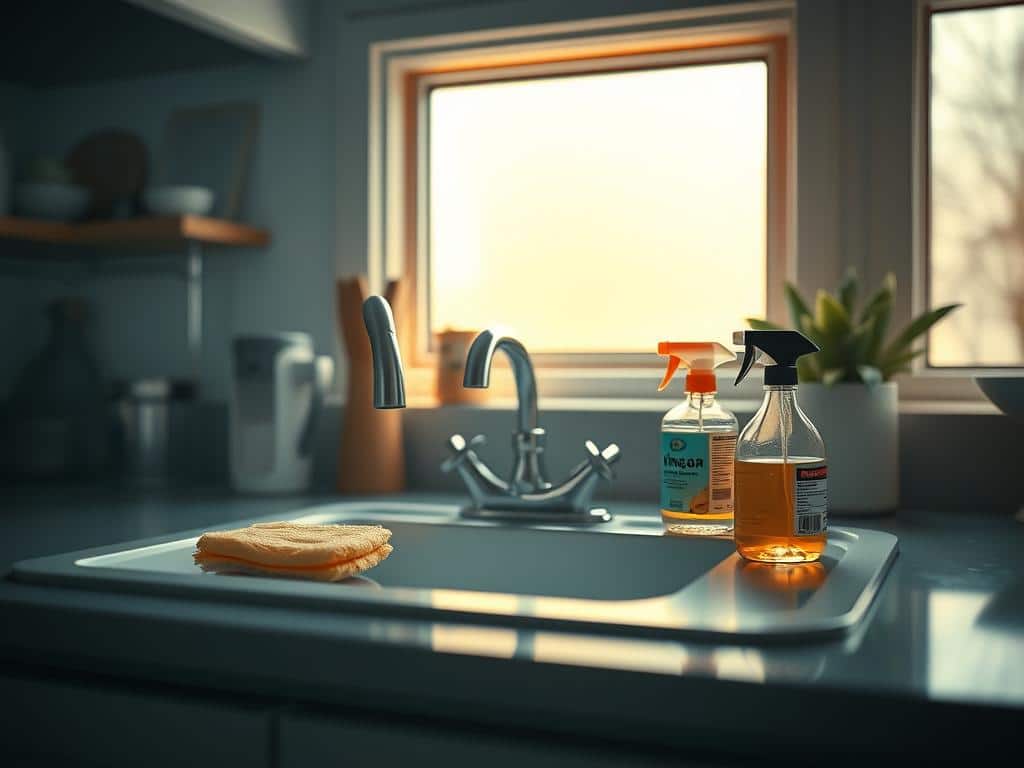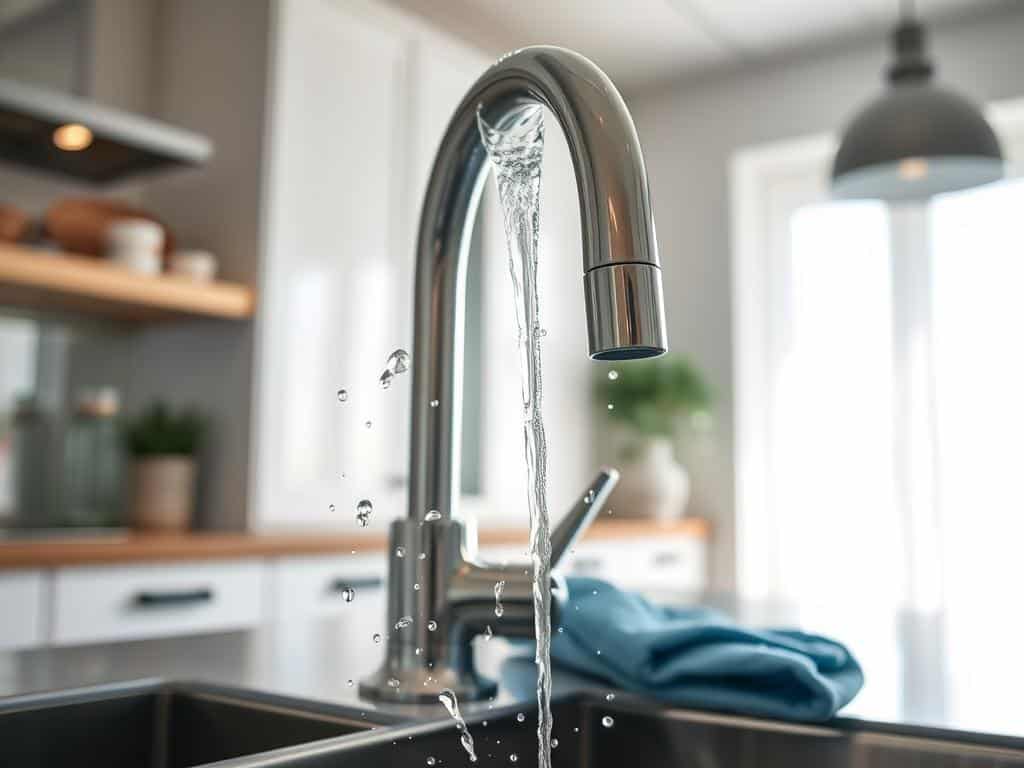
Maintaining a spotless kitchen sink is crucial for a healthy and hygienic home. Regular kitchen sink maintenance ensures your sink and drain stays clean and free from unpleasant odors. Start your sink cleaning routine by clearing the area and pre-rinsing the sink. This simple task, which takes about 10 minutes, can transform your kitchen’s overall appearance.
Studies have shown that 45% of kitchen sink swabs tested positive for coliform bacteria like salmonella and E. coli, making it evident that knowing how to clean kitchen sink effectively is paramount. Begin with gentle cleaners like baking soda and dish soap for stainless steel, or opt for hydrogen peroxide for white sinks. Even lemon and salt work wonders for porcelain sinks. Each material demands unique cleaning techniques to maintain its longevity and aesthetic appeal.
Cleaning your kitchen sink should be part of your daily routine, while unclogging kitchen sink drains can be done weekly. By regularly washing dishes, disinfecting surfaces, and avoiding food buildup in the garbage disposal, you prevent harmful bacteria growth. For effective sink cleaning and deodorization, a combination of baking soda and vinegar, followed by a flush with hot water after five minutes, works wonders.
Investing in a good sink cleaning routine not only contributes to a fresh kitchen but also prevents the grime that can impact other areas of your home. Remember, the kitchen sink often harbors more bacteria than other common household areas, so stay committed to keeping it clean for both health and aesthetic reasons.
Gathering the Necessary Supplies
Equipping yourself with the right cleaning supplies is essential for effective kitchen cleaning. Not only does this simplify your tasks, but it also promotes an eco-friendly cleaning routine. This guide will help you gather all the necessary items to tackle different cleaning challenges in the kitchen, especially focusing on your sink and drain.
Household Items You Need
You’ll need basic cleaning supplies like sponges, microfiber cloths, and a spray bottle filled with an all-purpose cleaner. Items like baking soda, dish soap, and vinegar are excellent choices for DIY sink cleaning. Citrus fruits such as lemons can act as effective cleaning agents for cutting through grease and grime.
- Baking soda
- Dish soap
- Vinegar
- Hydrogen peroxide
- Microfiber cloths
- Sponges
- Citrus fruits (lemons)
According to experts, maintaining a clean and organized kitchen protects your family from harmful bacteria and pests. Regular deep cleaning, recommended at least four times a year, can help ensure a healthier environment.
Optional Cleaning Tools
For tougher cleaning tasks, additional kitchen cleaning tools may be required. Rubber gloves can protect your hands from harsh chemicals, while a rubber plunger and a drain snake are perfect for clearing stubborn clogs. Keeping in mind the material of your sink is crucial; certain types may need non-abrasive tools to prevent any damage.
- Rubber gloves
- Rubber plunger
- Drain snake
- Non-abrasive scrubbers
For those interested in eco-friendly cleaning methods, consider integrating sustainable practices. For instance, using natural cleaners like vinegar, baking soda, and lemon not only ensures your kitchen remains spotless but also minimizes environmental impact. You can learn more about such methods by visiting this guide. Additionally, hiring a professional cleaning service could be beneficial if your schedule doesn’t allow for regular deep cleaning sessions.
Preparing Your Sink for Cleaning
Proper sink cleaning preparation not only ensures a hygienic workspace but also simplifies the overall cleaning process. Start with these essential pre-cleaning sink tips to set the stage for an effective and thorough cleaning.

Clearing and Pre-Rinsing the Sink
Before diving into tackling tough sink stains, make sure to clear the area of all kitchenware, utensils, and dish racks. This is a pivotal first step in pre-cleaning sink tips. Once the sink is empty, give it a preliminary rinse to remove any loose crumbs or food particles. This initial rinse can be done using warm water and a soft sponge to ensure no surface debris remains. For those looking at how to remove sink stains effectively, this step clears the way for deeper cleaning tasks.
Removing Stubborn Debris
Sink cleaning preparation for stubborn debris varies based on sink material. For stainless steel sinks, avoid acidic cleaners and harsh scrubbing tools that may cause damage. Instead, sprinkle baking soda over the sink base and scrub using a wet soft sponge with dish soap in small circular motions. For porcelain and ceramic sinks, consider using baking soda and hydrogen peroxide to address tougher stains. Apply the mixture to the stained area and let it sit for a few minutes before gently scrubbing with a soft sponge.
Below is a detailed guide to addressing common stubborn debris based on sink types:
| Sink Type | Cleaning Steps |
|---|---|
| Stainless Steel | Sprinkle baking soda, scrub with dish soap and a wet soft sponge |
| Porcelain | Use baking soda and hydrogen peroxide, scrub with a soft sponge |
| Ceramic | Apply gentle dish soap, scrub in circular motions with a soft sponge |
| Granite | Spray water and vinegar mixture, scrub with a damp sponge after 15 minutes |
| Copper | Wash with mild dish soap, avoid abrasive cleaners |
These steps ensure that any sink, be it stainless steel, porcelain, or granite, is prepared to tackle tough sink stains efficiently. Remember, consistent sink cleaning preparation and following these proven techniques can make a significant difference in maintaining a pristine and functional kitchen sink.
How to Clean Kitchen Sink: Step-by-Step Guide
Cleaning your kitchen sink effectively requires a thorough understanding of various step-by-step sink cleaning techniques based on the material of your sink. Whether your sink is made of stainless steel or porcelain, attention to detail is paramount to ensure a spotless and hygienic result.
Scrubbing Techniques for Different Sink Materials
Begin your step-by-step sink cleaning by gathering a sponge or brush and creating a mixture of baking soda, dish soap, and water. This solution forms the foundation for a thorough cleaning job, irrespective of the sink material.
- Stainless Steel Sink Care: Gentle scrubbing is essential for stainless steel sink care to avoid water spots. Once scrubbing is complete, dry the sink with a microfiber cloth to prevent any residue.
- Porcelain Sink Maintenance: For porcelain sink maintenance, employ a combination of baking soda and hydrogen peroxide or a mixture of salt and lemon. These natural solutions effectively tackle rust and stubborn stains, maintaining the sink’s pearly finish.
Moving methodically from the basin’s sides to the center, push all grime towards the drain. Ensure that all surfaces are scum-free before rinsing thoroughly with water and drying each area. Incorporating these scrubbing techniques into your kitchen cleaning routine ensures a pristine and efficient workspace.
| Sink Material | Cleaning Method | Key Tips |
|---|---|---|
| Stainless Steel | Stainless steel sink care with baking soda, dish soap, water | Use gentle motion; dry with microfiber cloth |
| Porcelain | Porcelain sink maintenance with baking soda, hydrogen peroxide, salt, and lemon | Focus on rust removal; maintain pearly finish |
Cleaning and Deodorizing Your Drain
Maintaining a fresh and clean kitchen sink drain is crucial in preventing unpleasant odors and ensuring efficient water flow. Deodorizing drains and unclogging them naturally can be effectively achieved with a combination of common household items and proper techniques. High 5 Plumbing in Denver specializes in kitchen plumbing repair and recommends regular maintenance to avoid unpleasant smells and clogs.
Using Baking Soda and Vinegar
One of the most efficient methods for cleaning and deodorizing kitchen drains is the baking soda and vinegar cleaning method. With a simple 1:2 ratio, pour one cup of baking soda followed by two cups of white vinegar down the drain. This combination creates a foaming reaction that helps break down food particles and grease. After allowing the mixture to sit for a few minutes, flush the drain with boiling water to clear any remaining debris. For an added touch, you can add a few drops of essential oils to the baking soda to leave a pleasant scent.
Plunging and Other Mechanical Methods
If the baking soda and vinegar cleaning method doesn’t completely resolve the issue, effective plunging can often do the trick. Use a plunger with proper up-and-down motions to dislodge stubborn clogs. For more severe blockages, mechanical drain cleaning tools like a drain snake can be manually employed to remove trapped hair and other debris. Regularly cleaning your sink with soap and hot water and pouring a cup of bleach solution down the drain once a week can further help in deodorizing drains and preventing bacteria buildup. Professional plumbers also have access to special enzyme-based cleaners that can effectively eliminate odor-causing bacteria in your drains.



